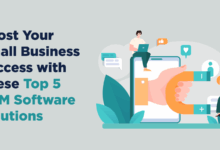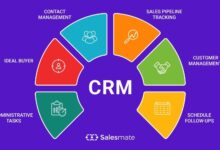CRM with AI Chatbot Integration: Enhanced Customer Engagement
CRM with AI Chatbot Integration represents a significant advancement in customer relationship management. This powerful combination leverages artificial intelligence to automate tasks, personalize interactions, and ultimately improve customer experiences. By integrating AI-powered chatbots into existing CRM systems, businesses can streamline operations, enhance efficiency, and gain valuable insights into customer behavior. This exploration delves into the functionalities, benefits, implementation strategies, and future trends of this transformative technology.
The integration of AI chatbots offers a multifaceted approach to improving various aspects of a business. From enhancing customer service responsiveness and improving lead generation to boosting sales conversion rates and increasing customer retention, the benefits are far-reaching. This analysis will examine the practical applications, security considerations, and potential challenges involved in successfully implementing this technology, providing a comprehensive overview for businesses seeking to optimize their customer interactions.
Defining CRM with AI Chatbot Integration
A Customer Relationship Management (CRM) system, at its core, is a software designed to manage and analyze customer interactions and data throughout the customer lifecycle. Its primary goal is to improve business relationships. This involves streamlining processes, improving customer service, and ultimately increasing profitability. Integrating AI chatbots significantly enhances these capabilities, leading to more efficient and effective customer interactions.
AI chatbot integration augments the traditional CRM functionalities by automating communication, providing instant support, and personalizing customer experiences. This integration allows businesses to handle a larger volume of inquiries simultaneously, freeing up human agents to focus on more complex tasks. The result is a more scalable and responsive customer service operation, leading to increased customer satisfaction and loyalty.
Types of AI Chatbots Used in CRM
Different types of AI chatbots offer varying levels of sophistication and capabilities within a CRM system. The choice depends on the specific needs and resources of the business.
- Rule-based chatbots: These chatbots operate on a predefined set of rules and decision trees. They are relatively simple to implement but lack the flexibility to handle complex or unexpected queries.
- Machine learning (ML)-based chatbots: These chatbots learn from past interactions and improve their responses over time. They can handle a wider range of queries and provide more personalized responses. This learning ability allows for continuous improvement in accuracy and efficiency.
- Natural Language Processing (NLP)-based chatbots: These are the most advanced type, capable of understanding and responding to human language in a natural and intuitive way. They use NLP techniques to interpret the nuances of human conversation, enabling more sophisticated and human-like interactions.
Industries Benefiting from CRM with AI Chatbot Integration
Numerous industries are leveraging the power of AI chatbot integration within their CRM systems to streamline operations and enhance customer experiences. The benefits are particularly pronounced in sectors with high customer interaction volumes or those requiring quick response times.
- E-commerce: AI chatbots can handle common customer inquiries like order tracking, returns, and shipping information, freeing up human agents to deal with more complex issues. Examples include companies like Amazon and Shopify utilizing chatbots for immediate customer support.
- Financial Services: Banks and insurance companies use AI chatbots to provide 24/7 customer support, answer account balance inquiries, and process simple transactions, leading to improved customer satisfaction and reduced operational costs. Examples include many large banks implementing chatbots for basic account management.
- Healthcare: Hospitals and clinics use chatbots to schedule appointments, answer patient questions, and provide medication reminders, improving patient engagement and reducing administrative burden. Examples include telehealth platforms incorporating chatbots for appointment scheduling and medication reminders.
Benefits of AI Chatbot Integration in CRM
Integrating AI-powered chatbots into your CRM system offers a multitude of advantages, significantly enhancing efficiency, customer experience, and ultimately, your bottom line. This integration streamlines various processes, leading to improved resource allocation and a more data-driven approach to customer relationship management.
Improved Customer Service Efficiency
AI chatbots provide instant, 24/7 customer support, addressing common queries and resolving simple issues without human intervention. This frees up human agents to focus on more complex problems requiring empathy and nuanced understanding, leading to increased overall efficiency. For instance, a company handling hundreds of basic inquiries daily can drastically reduce its customer service response time and agent workload by implementing an AI chatbot to handle routine requests. This translates to faster resolution times and improved customer satisfaction. The chatbot can also provide personalized responses based on customer data stored within the CRM, offering a more tailored and efficient service experience.
Impact on Lead Generation and Qualification
AI chatbots can proactively engage website visitors, gathering information through conversational interactions. This data is then seamlessly integrated into the CRM, automatically qualifying leads based on pre-defined criteria. For example, a chatbot can ask qualifying questions like budget, timeline, and project scope, effectively filtering out unqualified leads and prioritizing those most likely to convert. This automated lead qualification process significantly reduces the time sales teams spend on unqualified prospects, allowing them to focus their efforts on high-potential leads.
Enhanced Sales Conversion Rates
By providing immediate answers to customer queries and guiding them through the sales funnel, AI chatbots contribute directly to increased conversion rates. They can provide personalized product recommendations, offer discounts or promotions, and even guide customers through the checkout process. Imagine an e-commerce platform where a chatbot answers questions about shipping, returns, and product specifications in real-time, reducing friction points and guiding hesitant customers towards a purchase. This constant, personalized support increases the likelihood of a successful sale.
Improved Customer Satisfaction and Retention
AI chatbots offer immediate responses, personalized interactions, and consistent service, leading to significantly higher customer satisfaction. The readily available support improves the overall customer experience, fostering loyalty and reducing churn. A study by [Insert reputable source and study findings here, e.g., a Forrester report showing improved customer satisfaction scores with AI chatbot integration] highlights the positive correlation between AI chatbot usage and customer retention rates. Proactive communication, such as sending personalized birthday messages or follow-up emails after a purchase, further strengthens customer relationships.
Comparison of CRM Systems with and without AI Chatbot Integration
The following table compares CRM systems with and without AI chatbot integration, highlighting key differences in functionality and cost:
| Feature | CRM without AI Chatbot | CRM with AI Chatbot |
|---|---|---|
| Customer Support Availability | Limited to business hours | 24/7 availability |
| Lead Qualification | Manual process, time-consuming | Automated, efficient lead scoring and qualification |
| Sales Conversion Rates | Potentially lower due to slower response times and less personalized interactions | Potentially higher due to faster response times and personalized interactions |
| Cost | Lower initial investment | Higher initial investment, but potential for long-term cost savings through increased efficiency and improved conversion rates |
Implementation and Integration Strategies
Integrating an AI chatbot into your existing CRM system can significantly enhance customer interactions and streamline internal processes. This involves careful planning, selection of appropriate tools, and a phased approach to minimize disruption and maximize benefits. The process requires a blend of technical expertise and a deep understanding of your CRM’s capabilities and your business needs.
The process of integrating an AI chatbot into an existing CRM system typically involves several key steps, from initial assessment to ongoing monitoring and optimization. Challenges can arise at various stages, highlighting the importance of a well-defined strategy and robust testing procedures. A successful integration hinges on effective communication and collaboration between the IT team, CRM administrators, and the chatbot vendor or development team.
AI Chatbot Integration Process
Integrating an AI chatbot requires a structured approach. This process can be broken down into distinct phases, each with its own set of tasks and considerations. A well-defined plan minimizes risks and ensures a smooth transition.
- Needs Assessment and Planning: Define specific business goals for chatbot integration. Identify key customer pain points the chatbot will address. Assess the current CRM system’s capabilities and limitations regarding API access and data integration. Select a chatbot platform compatible with your CRM.
- Data Mapping and Preparation: Map the CRM data fields that the chatbot will need to access and utilize. Cleanse and prepare this data to ensure accuracy and consistency. This may involve data transformation or enrichment to optimize chatbot performance.
- API Integration and Configuration: Establish a secure connection between the chatbot platform and your CRM using APIs (Application Programming Interfaces). Configure the API to allow the chatbot to access and update CRM data, ensuring data security and privacy.
- Chatbot Development and Training: Develop the chatbot’s conversational flows and knowledge base. Train the chatbot using relevant data from your CRM and other sources to ensure accurate and helpful responses. This involves iterative testing and refinement.
- Testing and Quality Assurance: Thoroughly test the integrated system to identify and resolve any bugs or inconsistencies. Perform user acceptance testing (UAT) with real users to gather feedback and make necessary adjustments.
- Deployment and Monitoring: Deploy the integrated chatbot to your CRM system. Continuously monitor its performance, collect user feedback, and make adjustments as needed. This includes tracking key metrics such as customer satisfaction, resolution rates, and chatbot usage.
Challenges and Considerations During Implementation
Several challenges can arise during the implementation of an AI chatbot into a CRM system. Careful planning and proactive mitigation strategies are crucial for a successful outcome.
- Data Security and Privacy: Ensuring the security and privacy of customer data exchanged between the chatbot and CRM is paramount. Compliance with relevant regulations (e.g., GDPR, CCPA) is essential.
- Integration Complexity: Integrating a chatbot with a complex CRM system can be technically challenging, requiring expertise in both CRM and chatbot technologies. Compatibility issues may arise.
- Maintaining Data Consistency: Ensuring data consistency between the chatbot and CRM is crucial to avoid discrepancies and inaccuracies. Robust data synchronization mechanisms are needed.
- Training Data Quality: The quality of the training data directly impacts the chatbot’s performance. Insufficient or inaccurate data can lead to poor responses and user frustration.
- Scalability and Performance: The chatbot system should be scalable to handle increasing volumes of interactions without compromising performance. Load testing is crucial to ensure scalability.
Step-by-Step Guide for Successful Integration
A phased approach ensures a smooth and effective integration. This minimizes disruption and maximizes the chances of success.
- Phase 1: Assessment and Planning: Define objectives, assess current systems, choose a chatbot platform, and develop a detailed project plan.
- Phase 2: Data Preparation and Mapping: Cleanse and prepare CRM data, map relevant fields, and ensure data security.
- Phase 3: API Integration and Testing: Establish API connections, configure data flow, and perform rigorous testing.
- Phase 4: Chatbot Development and Training: Design conversational flows, build the knowledge base, and train the chatbot using relevant data.
- Phase 5: Deployment and Monitoring: Deploy the integrated system, monitor performance, and collect user feedback for continuous improvement.
AI Chatbot Features and Capabilities within CRM
Integrating AI-powered chatbots into your CRM system unlocks a wealth of capabilities, transforming how businesses interact with customers and manage internal processes. These chatbots go far beyond simple automated responses; they leverage sophisticated technologies to deliver personalized, efficient, and scalable customer service.
AI chatbots within a CRM environment are powered by a combination of Natural Language Processing (NLP), Machine Learning (ML), and advanced rule-based systems, enabling them to understand, respond to, and learn from customer interactions. This leads to improved customer satisfaction, increased operational efficiency, and valuable data insights for business improvement.
Natural Language Processing (NLP) Capabilities
NLP is the core technology enabling chatbots to understand human language. Within a CRM context, NLP allows chatbots to accurately interpret customer requests, even those expressed in informal or complex ways. This includes understanding intent, identifying key phrases and entities (like product names or order numbers), and extracting relevant information from the conversation. The chatbot can then use this understanding to provide appropriate responses and actions within the CRM system, such as updating customer records, creating support tickets, or routing the conversation to a human agent. This sophisticated understanding allows for more natural and effective interactions, improving the overall customer experience.
Machine Learning (ML) and Performance Improvement
Machine learning is crucial for the continuous improvement of chatbot performance. Through ML algorithms, the chatbot learns from each interaction, identifying patterns and improving its ability to understand and respond to future requests. This includes learning to recognize different phrasing styles, handling ambiguous queries more effectively, and refining its responses based on customer feedback and interaction outcomes. The more data the chatbot processes, the more accurate and efficient it becomes, resulting in a constantly evolving and self-improving system. For example, if a chatbot frequently misinterprets a particular phrase, the ML algorithms will adjust its NLP model to correctly interpret that phrase in the future.
Automated Responses, Personalized Interactions, and Proactive Support
AI-powered chatbots offer several key features that enhance customer service within a CRM. Automated responses handle common inquiries efficiently, freeing up human agents to focus on more complex issues. Personalization features allow chatbots to tailor their responses based on individual customer data stored within the CRM, providing a more relevant and engaging experience. Proactive support capabilities enable the chatbot to anticipate customer needs and offer assistance before a problem arises. For instance, a chatbot might proactively contact a customer whose order is delayed, providing an update and managing expectations.
Examples of AI Chatbot Handling Customer Inquiries within CRM
The following bullet points illustrate how AI chatbots handle diverse customer inquiries within a CRM environment:
- Order Tracking: A customer asks, “Where’s my order?”. The chatbot accesses the CRM, retrieves the order status, and provides the tracking information and estimated delivery date.
- Product Information: A customer asks about the specifications of a specific product. The chatbot pulls the relevant product details from the CRM and provides a concise summary, potentially including images and links to further information.
- Account Management: A customer requests a change to their billing address. The chatbot guides the customer through the process, updating the information in the CRM and sending a confirmation email.
- Technical Support: A customer reports a technical issue. The chatbot uses a knowledge base integrated within the CRM to identify potential solutions, guiding the customer through troubleshooting steps, and escalating the issue to a human agent if necessary.
- Sales Inquiries: A potential customer asks about pricing and availability. The chatbot accesses the CRM’s product catalog, provides pricing details, and checks inventory levels before providing a response.
Security and Privacy Considerations
Integrating AI chatbots into your CRM system offers significant advantages, but it also introduces new security and privacy challenges. Robust security protocols are crucial to protect sensitive customer data and maintain user trust. Failure to address these concerns can lead to data breaches, regulatory penalties, and reputational damage.
Data security protocols needed for AI chatbot integration in CRM involve a multi-layered approach encompassing data encryption, access control, and regular security audits. These measures are designed to minimize the risk of unauthorized access, use, disclosure, disruption, modification, or destruction of customer information.
Data Encryption and Access Control
Implementing robust encryption methods for both data at rest and data in transit is paramount. This involves encrypting all sensitive customer data stored in the CRM database and securing communication channels between the chatbot, the CRM system, and other connected systems using protocols like TLS/SSL. Access control mechanisms, such as role-based access control (RBAC), should be implemented to restrict access to sensitive data based on user roles and responsibilities. Only authorized personnel should have access to customer data, and their access should be regularly reviewed and audited.
Compliance with Data Privacy Regulations
Adherence to data privacy regulations like GDPR, CCPA, and others is non-negotiable. This requires implementing mechanisms to obtain and document user consent for data collection and processing, providing users with transparency about how their data is used, and enabling them to exercise their rights to access, correct, or delete their data. Data retention policies should be clearly defined and implemented, ensuring that data is only retained for as long as necessary. Regular audits should be conducted to ensure ongoing compliance. For example, a company could implement a system where all user data requests are logged and reviewed to ensure compliance with GDPR’s “right to be forgotten” provision.
Protecting Sensitive Customer Information
Protecting sensitive customer information requires a combination of technical and organizational measures. These include implementing intrusion detection and prevention systems to monitor for and respond to security threats, conducting regular security assessments and penetration testing to identify vulnerabilities, and establishing incident response plans to handle data breaches effectively. Employee training on data security best practices is also crucial to minimize the risk of human error. For instance, implementing multi-factor authentication (MFA) for all users accessing the CRM system adds an extra layer of security, significantly reducing the risk of unauthorized access.
Best Practices for Managing User Data and Maintaining Transparency
Maintaining transparency with users about data collection and usage practices is crucial for building trust. Clear and concise privacy policies should be readily available to users, explaining how their data is collected, used, and protected. Users should be given control over their data, including the ability to access, correct, and delete their information. Regularly reviewing and updating privacy policies to reflect changes in data practices is essential. For example, a company could implement a user dashboard where users can view and manage their data, including preferences for communication and data sharing. This demonstrates a commitment to transparency and user control.
Future Trends and Developments
The integration of AI chatbots within CRM systems is rapidly evolving, promising a future where customer interactions are more efficient, personalized, and insightful. Several key trends are shaping this evolution, driven by advancements in AI technology and changing customer expectations. These trends will significantly impact how businesses manage customer relationships and leverage data for improved outcomes.
The next five years will witness a dramatic shift in the capabilities and applications of AI chatbots within CRM. Emerging technologies will play a crucial role in this transformation, leading to more sophisticated and human-like interactions.
The Rise of Hyper-Personalization
AI’s ability to analyze vast amounts of customer data allows for unprecedented levels of personalization. Future CRM systems will leverage AI to create highly tailored customer journeys, anticipating needs and proactively addressing concerns. This will move beyond simple personalized greetings to dynamically adjusting product recommendations, offers, and support based on real-time customer behavior and preferences. For example, an e-commerce platform could use AI to suggest products based not only on past purchases but also on current browsing behavior, social media activity, and even weather patterns in the customer’s location.
The Integration of Voice Assistants
Voice assistants, like Amazon Alexa and Google Assistant, are becoming increasingly prevalent in daily life. Their seamless integration with CRM systems will enable hands-free customer service and access to information. Customers will be able to interact with their CRM data and receive support through voice commands, enhancing convenience and accessibility. This integration will also allow for more natural and intuitive interactions, making the customer experience more fluid and less reliant on typing. Imagine a customer using a voice assistant to check their order status, request a return, or ask a question about a product, all without ever opening an app or website.
Predictive Analytics and Proactive Support
AI-powered predictive analytics will play a more significant role in anticipating customer needs and proactively offering support. By analyzing historical data and identifying patterns, CRM systems can predict potential issues, such as churn risk or product malfunctions, and take preemptive measures to address them. This proactive approach will lead to improved customer satisfaction and loyalty. For instance, a telecommunications company could use predictive analytics to identify customers at high risk of churning and offer them personalized retention offers before they cancel their service.
Enhanced Natural Language Processing (NLP)
Advancements in NLP will enable AI chatbots to understand and respond to more complex and nuanced customer queries. This will lead to more human-like interactions and reduce the need for human intervention in many cases. Future chatbots will be capable of understanding context, sentiment, and intent with greater accuracy, leading to more effective and satisfying customer interactions. This will allow businesses to handle a wider range of customer inquiries efficiently and effectively.
Infographic: The Evolution of AI Chatbots in CRM (Next 5 Years)
The infographic would be a timeline depicting the evolution of AI chatbots in CRM over the next five years.
Year 1: Basic chatbot functionality – primarily answering frequently asked questions (FAQs) and providing basic customer support. Visual representation: A simple chatbot icon with limited features.
Year 2: Integration with CRM data – chatbots access customer data to personalize interactions and offer relevant information. Visual representation: Chatbot icon connected to a database icon.
Year 3: Advanced NLP and sentiment analysis – chatbots understand complex queries, identify customer sentiment, and tailor responses accordingly. Visual representation: Chatbot icon with a speech bubble showing diverse emotions.
Year 4: Proactive support and predictive analytics – chatbots anticipate customer needs and proactively offer assistance, reducing customer churn. Visual representation: Chatbot icon with a predictive analytics graph.
Year 5: Seamless voice integration and hyper-personalization – chatbots integrate with voice assistants, offering hands-free support and highly tailored experiences. Visual representation: Chatbot icon merging with a voice assistant icon, showing highly personalized interactions.
Case Studies and Examples
Successful CRM implementations integrated with AI chatbots have demonstrably improved customer engagement, operational efficiency, and overall business performance across diverse sectors. This section examines several case studies illustrating the tangible benefits of this integration, highlighting varying approaches and addressing specific business challenges.
Analyzing these case studies reveals common themes: improved customer service metrics, streamlined lead generation processes, and increased sales conversion rates. The specific implementation strategies, however, vary based on industry needs and existing CRM infrastructure.
AI Chatbot Integration in E-commerce: A Case Study of ShoeMart
ShoeMart, a large online retailer, integrated an AI-powered chatbot into its Salesforce CRM. The chatbot handled routine customer inquiries regarding order status, shipping information, and return policies, freeing up human agents to focus on more complex issues. This resulted in a 20% reduction in average customer service response time and a 15% increase in customer satisfaction scores, as measured by post-interaction surveys. The chatbot also proactively engaged customers with personalized product recommendations based on their browsing history and purchase patterns, leading to a 10% increase in average order value. The integration leveraged Salesforce’s APIs to seamlessly connect the chatbot to the CRM’s customer data and order management system.
AI Chatbot Integration in Banking: Example of First National Bank
First National Bank implemented a chatbot within its existing CRM to automate appointment scheduling and provide 24/7 account balance inquiries and transaction history access. This reduced call center volume by 30%, freeing up staff for more complex customer needs and resulting in significant cost savings. The chatbot also proactively alerted customers to potential fraud, significantly reducing the number of fraudulent transactions. The system utilized natural language processing (NLP) to understand customer requests and integrate with the bank’s core banking system via secure APIs. The success was measured by a decrease in customer service costs and an increase in customer trust due to proactive fraud detection.
Comparison of AI Chatbot Integration Approaches Across Industries
| Industry | Approach | Key Metrics Improved | Challenges Addressed |
|---|---|---|---|
| E-commerce | Proactive engagement, personalized recommendations, automated order tracking | Customer satisfaction, average order value, customer service response time | High customer service volume, cart abandonment |
| Banking | Automated account access, appointment scheduling, fraud detection | Call center efficiency, customer service costs, fraud rates | High call volumes, limited customer service hours, fraud prevention |
| Healthcare | Appointment scheduling, medication reminders, patient intake forms | Patient satisfaction, appointment adherence, administrative efficiency | Appointment scheduling bottlenecks, patient communication challenges |
Final Thoughts
In conclusion, CRM with AI chatbot integration offers a compelling pathway to enhanced customer engagement and operational efficiency. By carefully considering implementation strategies, security protocols, and future trends, businesses can harness the power of AI to transform their customer interactions, ultimately driving growth and achieving a competitive edge. The potential for personalized experiences, improved customer satisfaction, and streamlined processes makes this integration a strategic imperative for organizations seeking to thrive in today’s dynamic market.





